Analysis of Ethical Dilemma and ACS Code of Professional Conduct
VerifiedAdded on 2022/09/26
|9
|2192
|31
Report
AI Summary
This report presents an analysis of an ethical dilemma faced by an ICT professional, 'Ken,' as depicted in three YouTube videos. The scenario involves a conflict between launching an untested system and adhering to ethical standards. The report identifies the ethical dilemma, analyzes the situation from the perspective of the Australian Computer Society (ACS) Code of Professional Conduct, and provides recommendations based on this analysis. The report considers the implications of different actions taken by Ken, including the potential consequences of launching the system without proper testing, the importance of professional integrity, and the impact on stakeholders. The analysis is supported by relevant academic references and aims to provide a comprehensive understanding of the ethical considerations in the context of ICT professional conduct. The report emphasizes the importance of ethical decision-making, particularly in situations where public interest, quality of life, honesty, competency, professionalism, and professional development are at stake. The best option is for the management to comply with Ken's suggestions, which improves the organization's reputation.
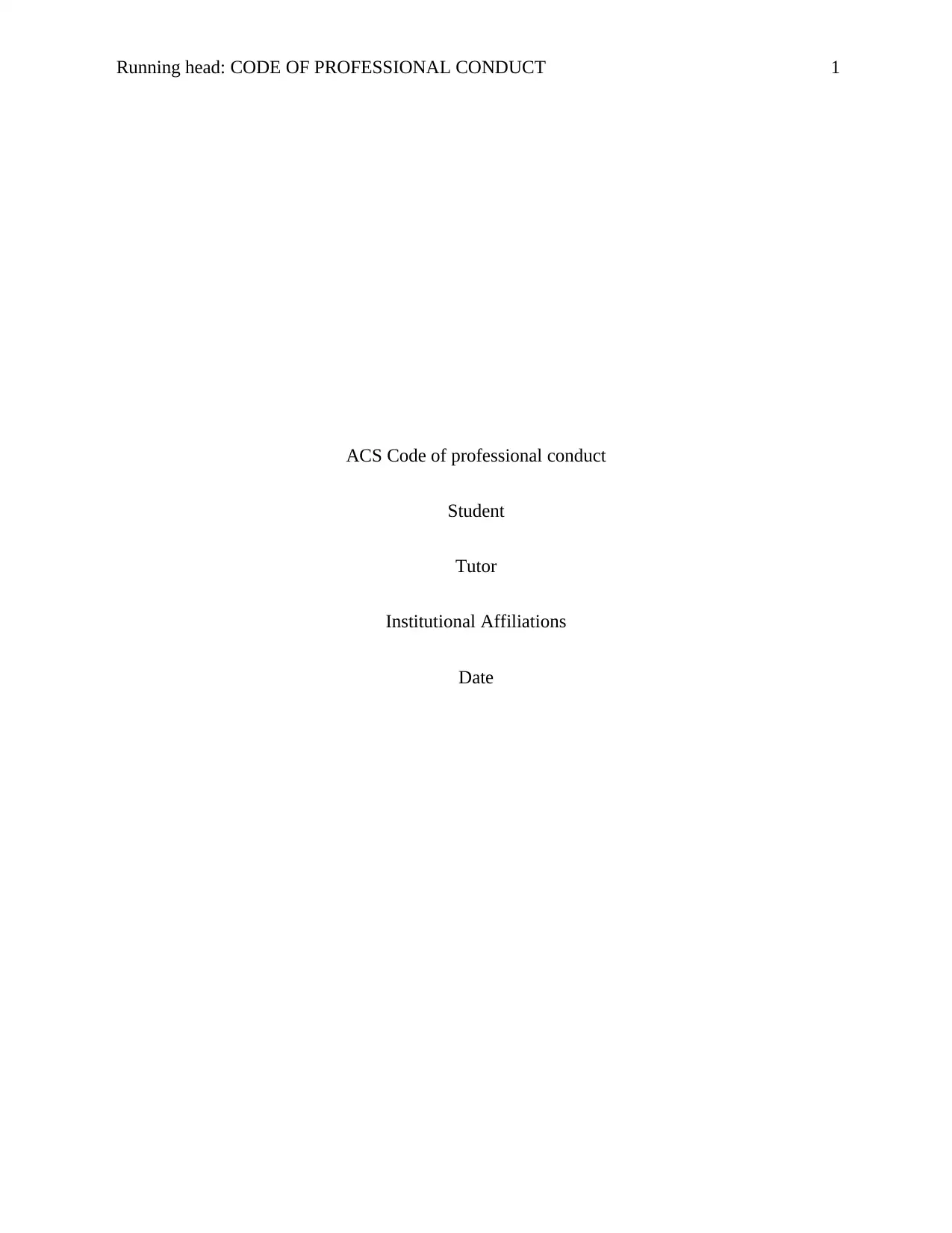
Running head: CODE OF PROFESSIONAL CONDUCT 1
ACS Code of professional conduct
Student
Tutor
Institutional Affiliations
Date
ACS Code of professional conduct
Student
Tutor
Institutional Affiliations
Date
Paraphrase This Document
Need a fresh take? Get an instant paraphrase of this document with our AI Paraphraser
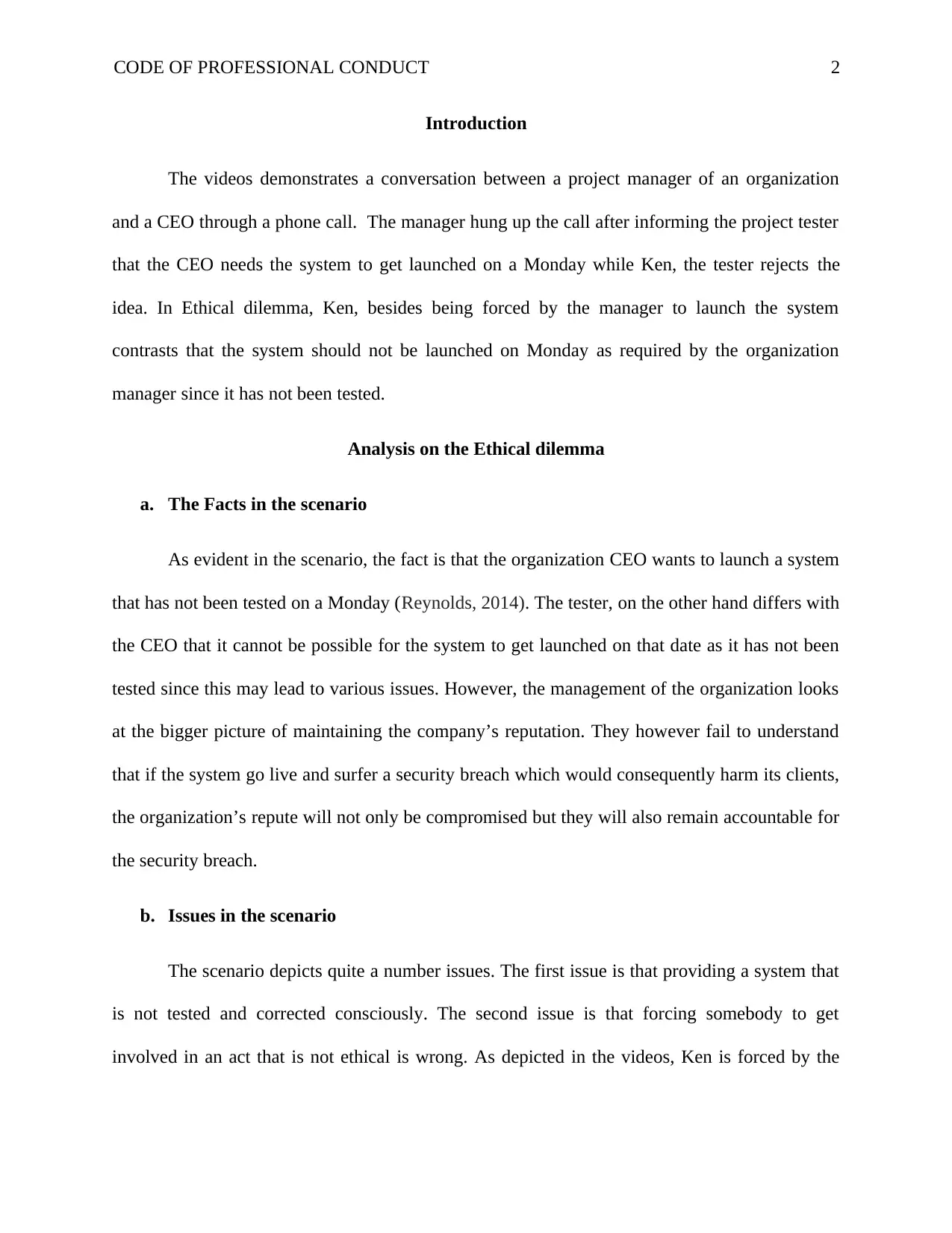
CODE OF PROFESSIONAL CONDUCT 2
Introduction
The videos demonstrates a conversation between a project manager of an organization
and a CEO through a phone call. The manager hung up the call after informing the project tester
that the CEO needs the system to get launched on a Monday while Ken, the tester rejects the
idea. In Ethical dilemma, Ken, besides being forced by the manager to launch the system
contrasts that the system should not be launched on Monday as required by the organization
manager since it has not been tested.
Analysis on the Ethical dilemma
a. The Facts in the scenario
As evident in the scenario, the fact is that the organization CEO wants to launch a system
that has not been tested on a Monday (Reynolds, 2014). The tester, on the other hand differs with
the CEO that it cannot be possible for the system to get launched on that date as it has not been
tested since this may lead to various issues. However, the management of the organization looks
at the bigger picture of maintaining the company’s reputation. They however fail to understand
that if the system go live and surfer a security breach which would consequently harm its clients,
the organization’s repute will not only be compromised but they will also remain accountable for
the security breach.
b. Issues in the scenario
The scenario depicts quite a number issues. The first issue is that providing a system that
is not tested and corrected consciously. The second issue is that forcing somebody to get
involved in an act that is not ethical is wrong. As depicted in the videos, Ken is forced by the
Introduction
The videos demonstrates a conversation between a project manager of an organization
and a CEO through a phone call. The manager hung up the call after informing the project tester
that the CEO needs the system to get launched on a Monday while Ken, the tester rejects the
idea. In Ethical dilemma, Ken, besides being forced by the manager to launch the system
contrasts that the system should not be launched on Monday as required by the organization
manager since it has not been tested.
Analysis on the Ethical dilemma
a. The Facts in the scenario
As evident in the scenario, the fact is that the organization CEO wants to launch a system
that has not been tested on a Monday (Reynolds, 2014). The tester, on the other hand differs with
the CEO that it cannot be possible for the system to get launched on that date as it has not been
tested since this may lead to various issues. However, the management of the organization looks
at the bigger picture of maintaining the company’s reputation. They however fail to understand
that if the system go live and surfer a security breach which would consequently harm its clients,
the organization’s repute will not only be compromised but they will also remain accountable for
the security breach.
b. Issues in the scenario
The scenario depicts quite a number issues. The first issue is that providing a system that
is not tested and corrected consciously. The second issue is that forcing somebody to get
involved in an act that is not ethical is wrong. As depicted in the videos, Ken is forced by the
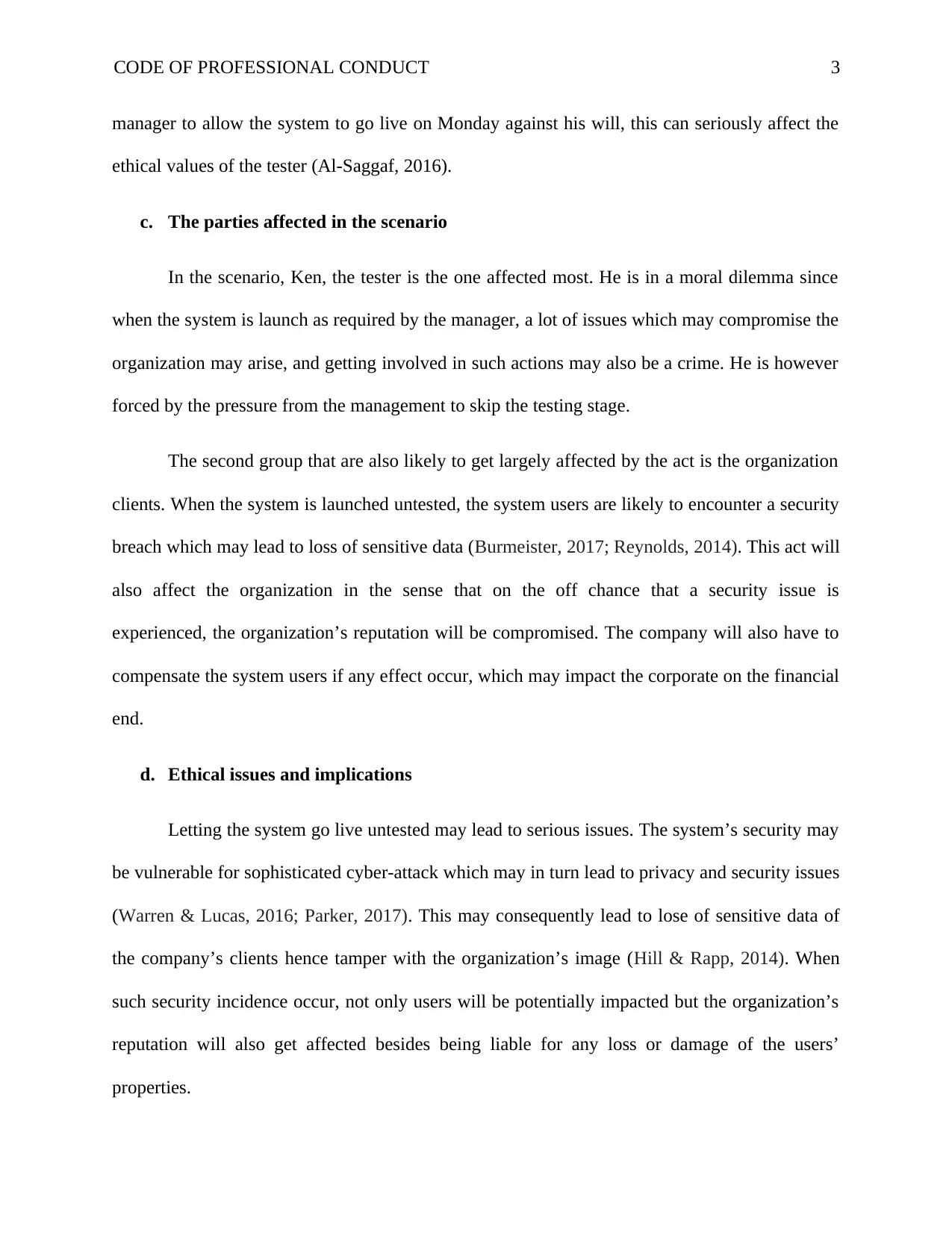
CODE OF PROFESSIONAL CONDUCT 3
manager to allow the system to go live on Monday against his will, this can seriously affect the
ethical values of the tester (Al-Saggaf, 2016).
c. The parties affected in the scenario
In the scenario, Ken, the tester is the one affected most. He is in a moral dilemma since
when the system is launch as required by the manager, a lot of issues which may compromise the
organization may arise, and getting involved in such actions may also be a crime. He is however
forced by the pressure from the management to skip the testing stage.
The second group that are also likely to get largely affected by the act is the organization
clients. When the system is launched untested, the system users are likely to encounter a security
breach which may lead to loss of sensitive data (Burmeister, 2017; Reynolds, 2014). This act will
also affect the organization in the sense that on the off chance that a security issue is
experienced, the organization’s reputation will be compromised. The company will also have to
compensate the system users if any effect occur, which may impact the corporate on the financial
end.
d. Ethical issues and implications
Letting the system go live untested may lead to serious issues. The system’s security may
be vulnerable for sophisticated cyber-attack which may in turn lead to privacy and security issues
(Warren & Lucas, 2016; Parker, 2017). This may consequently lead to lose of sensitive data of
the company’s clients hence tamper with the organization’s image (Hill & Rapp, 2014). When
such security incidence occur, not only users will be potentially impacted but the organization’s
reputation will also get affected besides being liable for any loss or damage of the users’
properties.
manager to allow the system to go live on Monday against his will, this can seriously affect the
ethical values of the tester (Al-Saggaf, 2016).
c. The parties affected in the scenario
In the scenario, Ken, the tester is the one affected most. He is in a moral dilemma since
when the system is launch as required by the manager, a lot of issues which may compromise the
organization may arise, and getting involved in such actions may also be a crime. He is however
forced by the pressure from the management to skip the testing stage.
The second group that are also likely to get largely affected by the act is the organization
clients. When the system is launched untested, the system users are likely to encounter a security
breach which may lead to loss of sensitive data (Burmeister, 2017; Reynolds, 2014). This act will
also affect the organization in the sense that on the off chance that a security issue is
experienced, the organization’s reputation will be compromised. The company will also have to
compensate the system users if any effect occur, which may impact the corporate on the financial
end.
d. Ethical issues and implications
Letting the system go live untested may lead to serious issues. The system’s security may
be vulnerable for sophisticated cyber-attack which may in turn lead to privacy and security issues
(Warren & Lucas, 2016; Parker, 2017). This may consequently lead to lose of sensitive data of
the company’s clients hence tamper with the organization’s image (Hill & Rapp, 2014). When
such security incidence occur, not only users will be potentially impacted but the organization’s
reputation will also get affected besides being liable for any loss or damage of the users’
properties.
⊘ This is a preview!⊘
Do you want full access?
Subscribe today to unlock all pages.

Trusted by 1+ million students worldwide
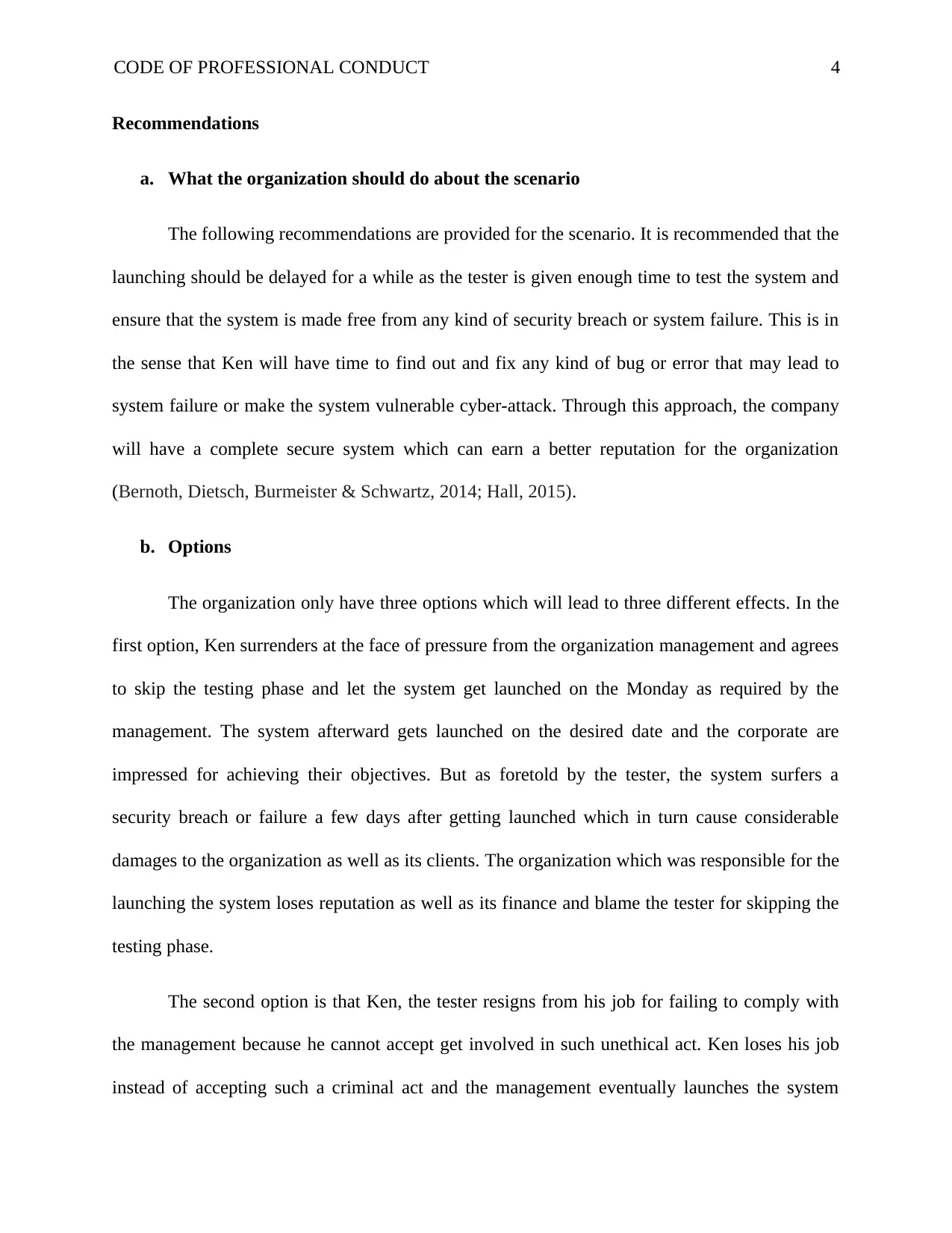
CODE OF PROFESSIONAL CONDUCT 4
Recommendations
a. What the organization should do about the scenario
The following recommendations are provided for the scenario. It is recommended that the
launching should be delayed for a while as the tester is given enough time to test the system and
ensure that the system is made free from any kind of security breach or system failure. This is in
the sense that Ken will have time to find out and fix any kind of bug or error that may lead to
system failure or make the system vulnerable cyber-attack. Through this approach, the company
will have a complete secure system which can earn a better reputation for the organization
(Bernoth, Dietsch, Burmeister & Schwartz, 2014; Hall, 2015).
b. Options
The organization only have three options which will lead to three different effects. In the
first option, Ken surrenders at the face of pressure from the organization management and agrees
to skip the testing phase and let the system get launched on the Monday as required by the
management. The system afterward gets launched on the desired date and the corporate are
impressed for achieving their objectives. But as foretold by the tester, the system surfers a
security breach or failure a few days after getting launched which in turn cause considerable
damages to the organization as well as its clients. The organization which was responsible for the
launching the system loses reputation as well as its finance and blame the tester for skipping the
testing phase.
The second option is that Ken, the tester resigns from his job for failing to comply with
the management because he cannot accept get involved in such unethical act. Ken loses his job
instead of accepting such a criminal act and the management eventually launches the system
Recommendations
a. What the organization should do about the scenario
The following recommendations are provided for the scenario. It is recommended that the
launching should be delayed for a while as the tester is given enough time to test the system and
ensure that the system is made free from any kind of security breach or system failure. This is in
the sense that Ken will have time to find out and fix any kind of bug or error that may lead to
system failure or make the system vulnerable cyber-attack. Through this approach, the company
will have a complete secure system which can earn a better reputation for the organization
(Bernoth, Dietsch, Burmeister & Schwartz, 2014; Hall, 2015).
b. Options
The organization only have three options which will lead to three different effects. In the
first option, Ken surrenders at the face of pressure from the organization management and agrees
to skip the testing phase and let the system get launched on the Monday as required by the
management. The system afterward gets launched on the desired date and the corporate are
impressed for achieving their objectives. But as foretold by the tester, the system surfers a
security breach or failure a few days after getting launched which in turn cause considerable
damages to the organization as well as its clients. The organization which was responsible for the
launching the system loses reputation as well as its finance and blame the tester for skipping the
testing phase.
The second option is that Ken, the tester resigns from his job for failing to comply with
the management because he cannot accept get involved in such unethical act. Ken loses his job
instead of accepting such a criminal act and the management eventually launches the system
Paraphrase This Document
Need a fresh take? Get an instant paraphrase of this document with our AI Paraphraser
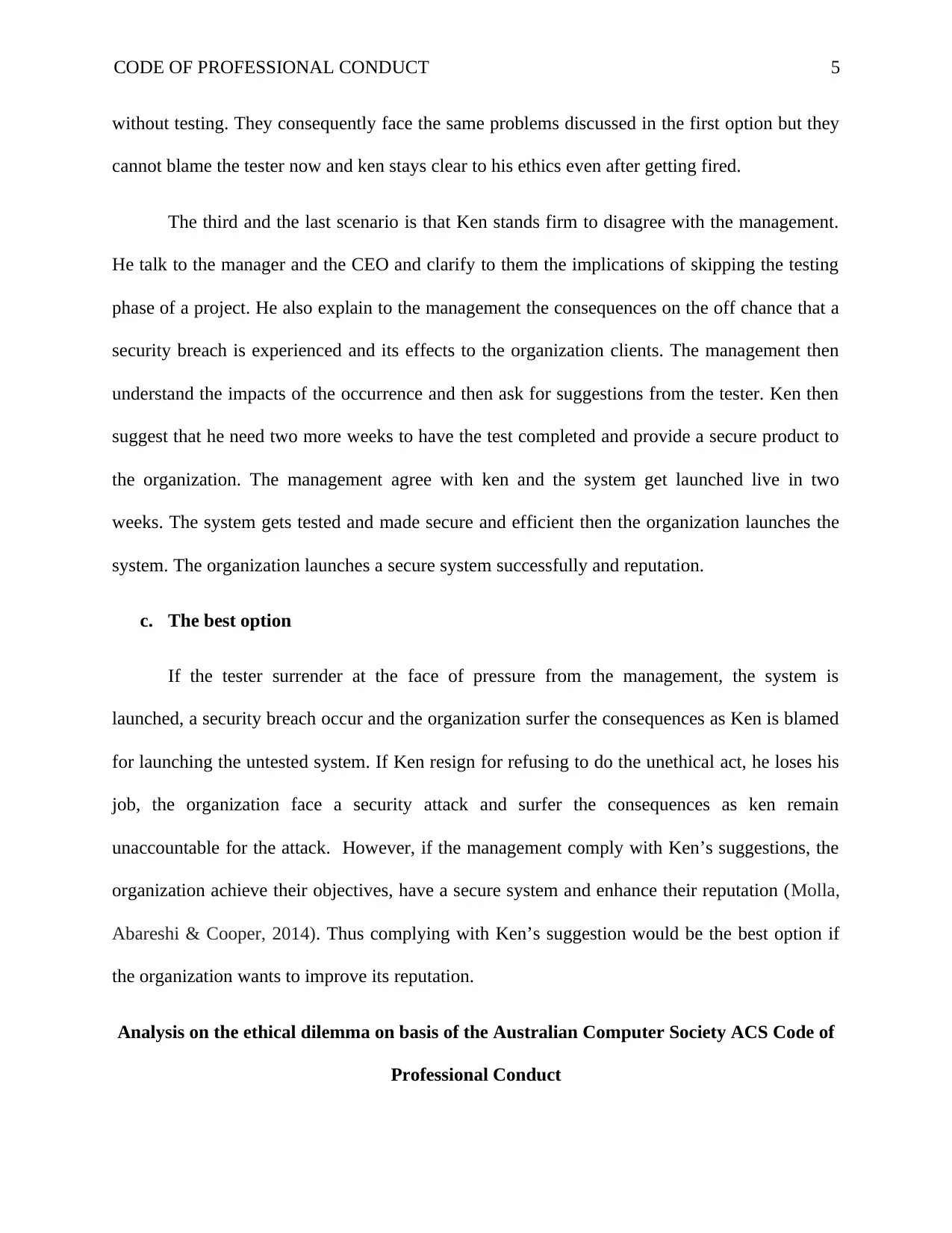
CODE OF PROFESSIONAL CONDUCT 5
without testing. They consequently face the same problems discussed in the first option but they
cannot blame the tester now and ken stays clear to his ethics even after getting fired.
The third and the last scenario is that Ken stands firm to disagree with the management.
He talk to the manager and the CEO and clarify to them the implications of skipping the testing
phase of a project. He also explain to the management the consequences on the off chance that a
security breach is experienced and its effects to the organization clients. The management then
understand the impacts of the occurrence and then ask for suggestions from the tester. Ken then
suggest that he need two more weeks to have the test completed and provide a secure product to
the organization. The management agree with ken and the system get launched live in two
weeks. The system gets tested and made secure and efficient then the organization launches the
system. The organization launches a secure system successfully and reputation.
c. The best option
If the tester surrender at the face of pressure from the management, the system is
launched, a security breach occur and the organization surfer the consequences as Ken is blamed
for launching the untested system. If Ken resign for refusing to do the unethical act, he loses his
job, the organization face a security attack and surfer the consequences as ken remain
unaccountable for the attack. However, if the management comply with Ken’s suggestions, the
organization achieve their objectives, have a secure system and enhance their reputation (Molla,
Abareshi & Cooper, 2014). Thus complying with Ken’s suggestion would be the best option if
the organization wants to improve its reputation.
Analysis on the ethical dilemma on basis of the Australian Computer Society ACS Code of
Professional Conduct
without testing. They consequently face the same problems discussed in the first option but they
cannot blame the tester now and ken stays clear to his ethics even after getting fired.
The third and the last scenario is that Ken stands firm to disagree with the management.
He talk to the manager and the CEO and clarify to them the implications of skipping the testing
phase of a project. He also explain to the management the consequences on the off chance that a
security breach is experienced and its effects to the organization clients. The management then
understand the impacts of the occurrence and then ask for suggestions from the tester. Ken then
suggest that he need two more weeks to have the test completed and provide a secure product to
the organization. The management agree with ken and the system get launched live in two
weeks. The system gets tested and made secure and efficient then the organization launches the
system. The organization launches a secure system successfully and reputation.
c. The best option
If the tester surrender at the face of pressure from the management, the system is
launched, a security breach occur and the organization surfer the consequences as Ken is blamed
for launching the untested system. If Ken resign for refusing to do the unethical act, he loses his
job, the organization face a security attack and surfer the consequences as ken remain
unaccountable for the attack. However, if the management comply with Ken’s suggestions, the
organization achieve their objectives, have a secure system and enhance their reputation (Molla,
Abareshi & Cooper, 2014). Thus complying with Ken’s suggestion would be the best option if
the organization wants to improve its reputation.
Analysis on the ethical dilemma on basis of the Australian Computer Society ACS Code of
Professional Conduct
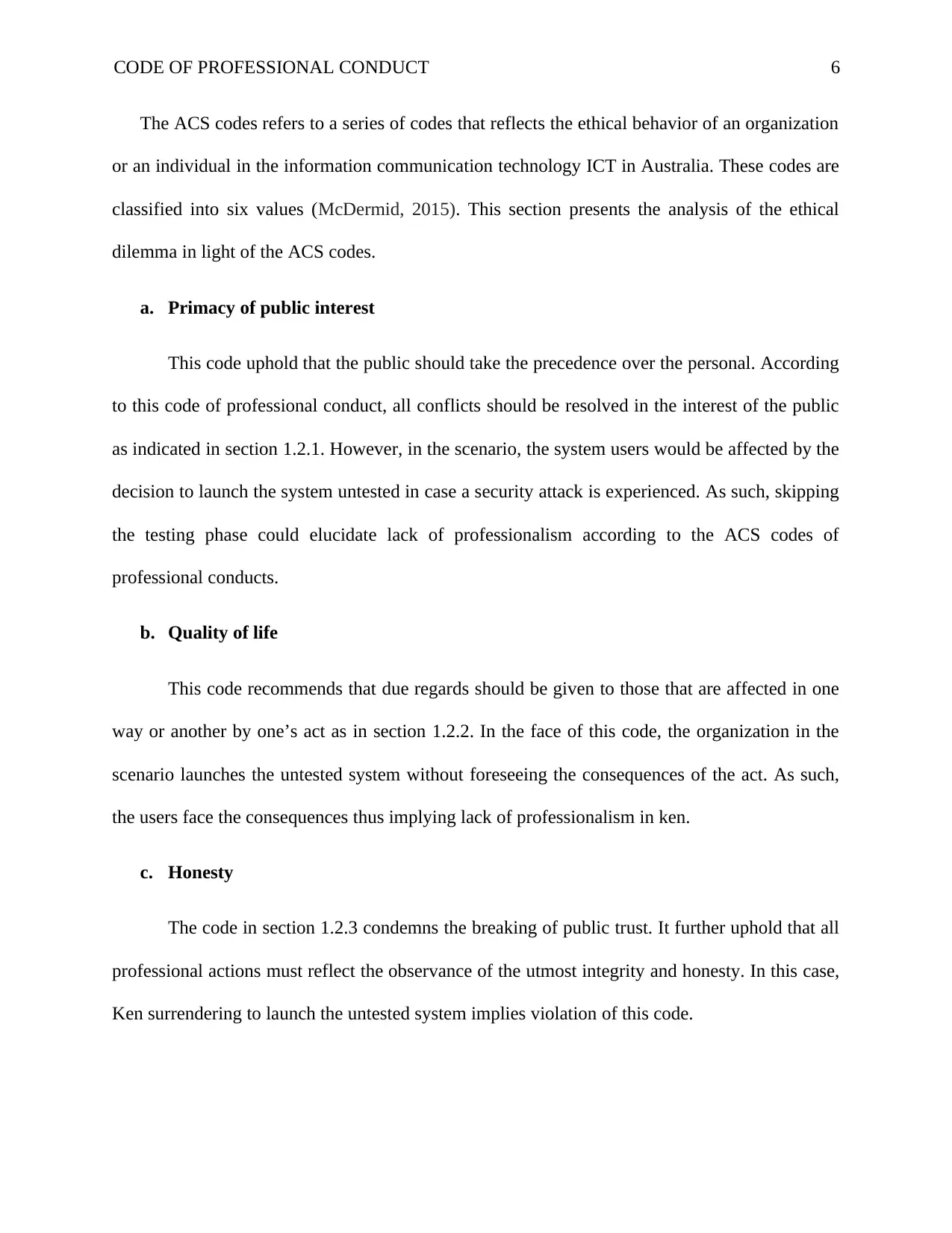
CODE OF PROFESSIONAL CONDUCT 6
The ACS codes refers to a series of codes that reflects the ethical behavior of an organization
or an individual in the information communication technology ICT in Australia. These codes are
classified into six values (McDermid, 2015). This section presents the analysis of the ethical
dilemma in light of the ACS codes.
a. Primacy of public interest
This code uphold that the public should take the precedence over the personal. According
to this code of professional conduct, all conflicts should be resolved in the interest of the public
as indicated in section 1.2.1. However, in the scenario, the system users would be affected by the
decision to launch the system untested in case a security attack is experienced. As such, skipping
the testing phase could elucidate lack of professionalism according to the ACS codes of
professional conducts.
b. Quality of life
This code recommends that due regards should be given to those that are affected in one
way or another by one’s act as in section 1.2.2. In the face of this code, the organization in the
scenario launches the untested system without foreseeing the consequences of the act. As such,
the users face the consequences thus implying lack of professionalism in ken.
c. Honesty
The code in section 1.2.3 condemns the breaking of public trust. It further uphold that all
professional actions must reflect the observance of the utmost integrity and honesty. In this case,
Ken surrendering to launch the untested system implies violation of this code.
The ACS codes refers to a series of codes that reflects the ethical behavior of an organization
or an individual in the information communication technology ICT in Australia. These codes are
classified into six values (McDermid, 2015). This section presents the analysis of the ethical
dilemma in light of the ACS codes.
a. Primacy of public interest
This code uphold that the public should take the precedence over the personal. According
to this code of professional conduct, all conflicts should be resolved in the interest of the public
as indicated in section 1.2.1. However, in the scenario, the system users would be affected by the
decision to launch the system untested in case a security attack is experienced. As such, skipping
the testing phase could elucidate lack of professionalism according to the ACS codes of
professional conducts.
b. Quality of life
This code recommends that due regards should be given to those that are affected in one
way or another by one’s act as in section 1.2.2. In the face of this code, the organization in the
scenario launches the untested system without foreseeing the consequences of the act. As such,
the users face the consequences thus implying lack of professionalism in ken.
c. Honesty
The code in section 1.2.3 condemns the breaking of public trust. It further uphold that all
professional actions must reflect the observance of the utmost integrity and honesty. In this case,
Ken surrendering to launch the untested system implies violation of this code.
⊘ This is a preview!⊘
Do you want full access?
Subscribe today to unlock all pages.

Trusted by 1+ million students worldwide
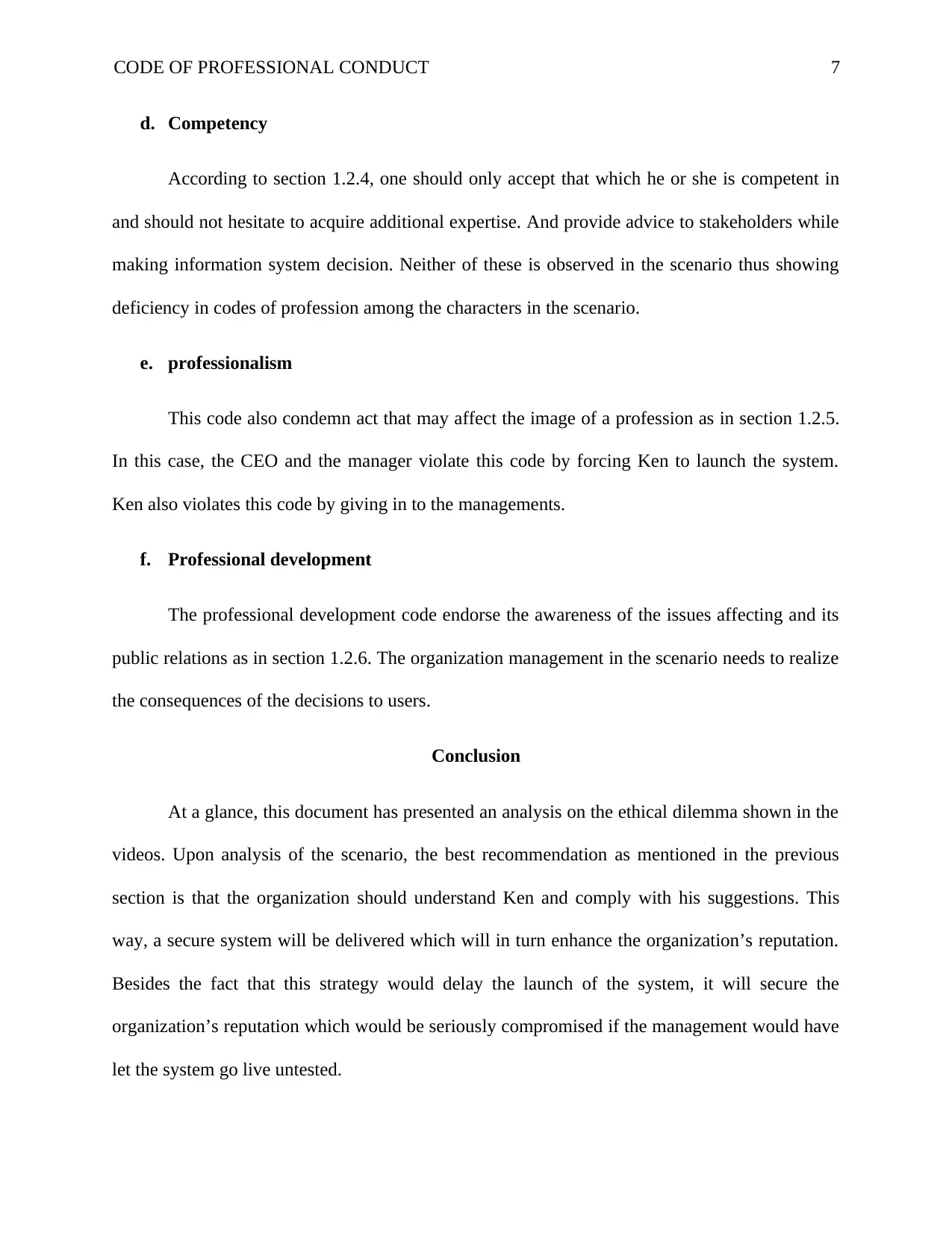
CODE OF PROFESSIONAL CONDUCT 7
d. Competency
According to section 1.2.4, one should only accept that which he or she is competent in
and should not hesitate to acquire additional expertise. And provide advice to stakeholders while
making information system decision. Neither of these is observed in the scenario thus showing
deficiency in codes of profession among the characters in the scenario.
e. professionalism
This code also condemn act that may affect the image of a profession as in section 1.2.5.
In this case, the CEO and the manager violate this code by forcing Ken to launch the system.
Ken also violates this code by giving in to the managements.
f. Professional development
The professional development code endorse the awareness of the issues affecting and its
public relations as in section 1.2.6. The organization management in the scenario needs to realize
the consequences of the decisions to users.
Conclusion
At a glance, this document has presented an analysis on the ethical dilemma shown in the
videos. Upon analysis of the scenario, the best recommendation as mentioned in the previous
section is that the organization should understand Ken and comply with his suggestions. This
way, a secure system will be delivered which will in turn enhance the organization’s reputation.
Besides the fact that this strategy would delay the launch of the system, it will secure the
organization’s reputation which would be seriously compromised if the management would have
let the system go live untested.
d. Competency
According to section 1.2.4, one should only accept that which he or she is competent in
and should not hesitate to acquire additional expertise. And provide advice to stakeholders while
making information system decision. Neither of these is observed in the scenario thus showing
deficiency in codes of profession among the characters in the scenario.
e. professionalism
This code also condemn act that may affect the image of a profession as in section 1.2.5.
In this case, the CEO and the manager violate this code by forcing Ken to launch the system.
Ken also violates this code by giving in to the managements.
f. Professional development
The professional development code endorse the awareness of the issues affecting and its
public relations as in section 1.2.6. The organization management in the scenario needs to realize
the consequences of the decisions to users.
Conclusion
At a glance, this document has presented an analysis on the ethical dilemma shown in the
videos. Upon analysis of the scenario, the best recommendation as mentioned in the previous
section is that the organization should understand Ken and comply with his suggestions. This
way, a secure system will be delivered which will in turn enhance the organization’s reputation.
Besides the fact that this strategy would delay the launch of the system, it will secure the
organization’s reputation which would be seriously compromised if the management would have
let the system go live untested.
Paraphrase This Document
Need a fresh take? Get an instant paraphrase of this document with our AI Paraphraser
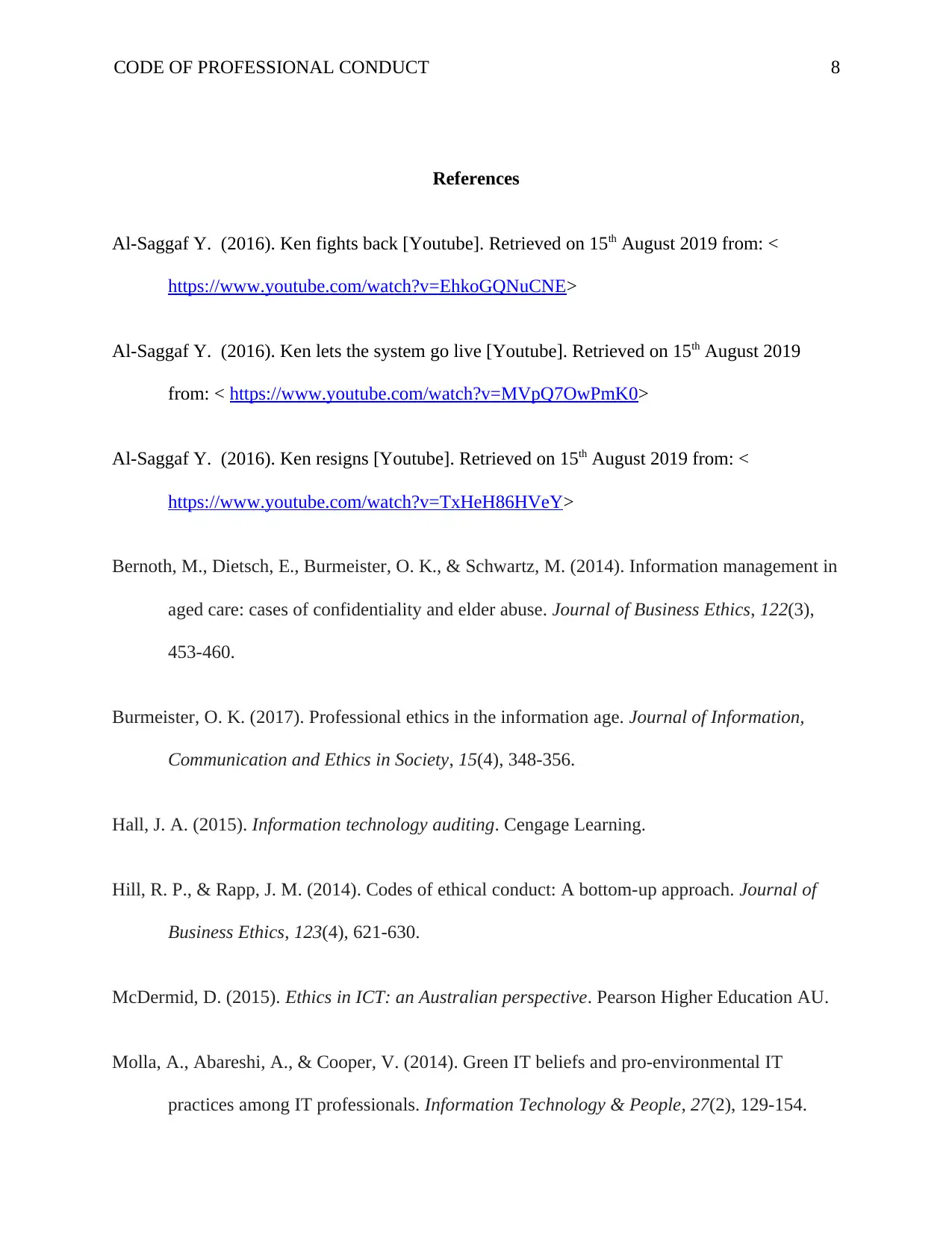
CODE OF PROFESSIONAL CONDUCT 8
References
Al-Saggaf Y. (2016). Ken fights back [Youtube]. Retrieved on 15th August 2019 from: <
https://www.youtube.com/watch?v=EhkoGQNuCNE>
Al-Saggaf Y. (2016). Ken lets the system go live [Youtube]. Retrieved on 15th August 2019
from: < https://www.youtube.com/watch?v=MVpQ7OwPmK0>
Al-Saggaf Y. (2016). Ken resigns [Youtube]. Retrieved on 15th August 2019 from: <
https://www.youtube.com/watch?v=TxHeH86HVeY>
Bernoth, M., Dietsch, E., Burmeister, O. K., & Schwartz, M. (2014). Information management in
aged care: cases of confidentiality and elder abuse. Journal of Business Ethics, 122(3),
453-460.
Burmeister, O. K. (2017). Professional ethics in the information age. Journal of Information,
Communication and Ethics in Society, 15(4), 348-356.
Hall, J. A. (2015). Information technology auditing. Cengage Learning.
Hill, R. P., & Rapp, J. M. (2014). Codes of ethical conduct: A bottom-up approach. Journal of
Business Ethics, 123(4), 621-630.
McDermid, D. (2015). Ethics in ICT: an Australian perspective. Pearson Higher Education AU.
Molla, A., Abareshi, A., & Cooper, V. (2014). Green IT beliefs and pro-environmental IT
practices among IT professionals. Information Technology & People, 27(2), 129-154.
References
Al-Saggaf Y. (2016). Ken fights back [Youtube]. Retrieved on 15th August 2019 from: <
https://www.youtube.com/watch?v=EhkoGQNuCNE>
Al-Saggaf Y. (2016). Ken lets the system go live [Youtube]. Retrieved on 15th August 2019
from: < https://www.youtube.com/watch?v=MVpQ7OwPmK0>
Al-Saggaf Y. (2016). Ken resigns [Youtube]. Retrieved on 15th August 2019 from: <
https://www.youtube.com/watch?v=TxHeH86HVeY>
Bernoth, M., Dietsch, E., Burmeister, O. K., & Schwartz, M. (2014). Information management in
aged care: cases of confidentiality and elder abuse. Journal of Business Ethics, 122(3),
453-460.
Burmeister, O. K. (2017). Professional ethics in the information age. Journal of Information,
Communication and Ethics in Society, 15(4), 348-356.
Hall, J. A. (2015). Information technology auditing. Cengage Learning.
Hill, R. P., & Rapp, J. M. (2014). Codes of ethical conduct: A bottom-up approach. Journal of
Business Ethics, 123(4), 621-630.
McDermid, D. (2015). Ethics in ICT: an Australian perspective. Pearson Higher Education AU.
Molla, A., Abareshi, A., & Cooper, V. (2014). Green IT beliefs and pro-environmental IT
practices among IT professionals. Information Technology & People, 27(2), 129-154.
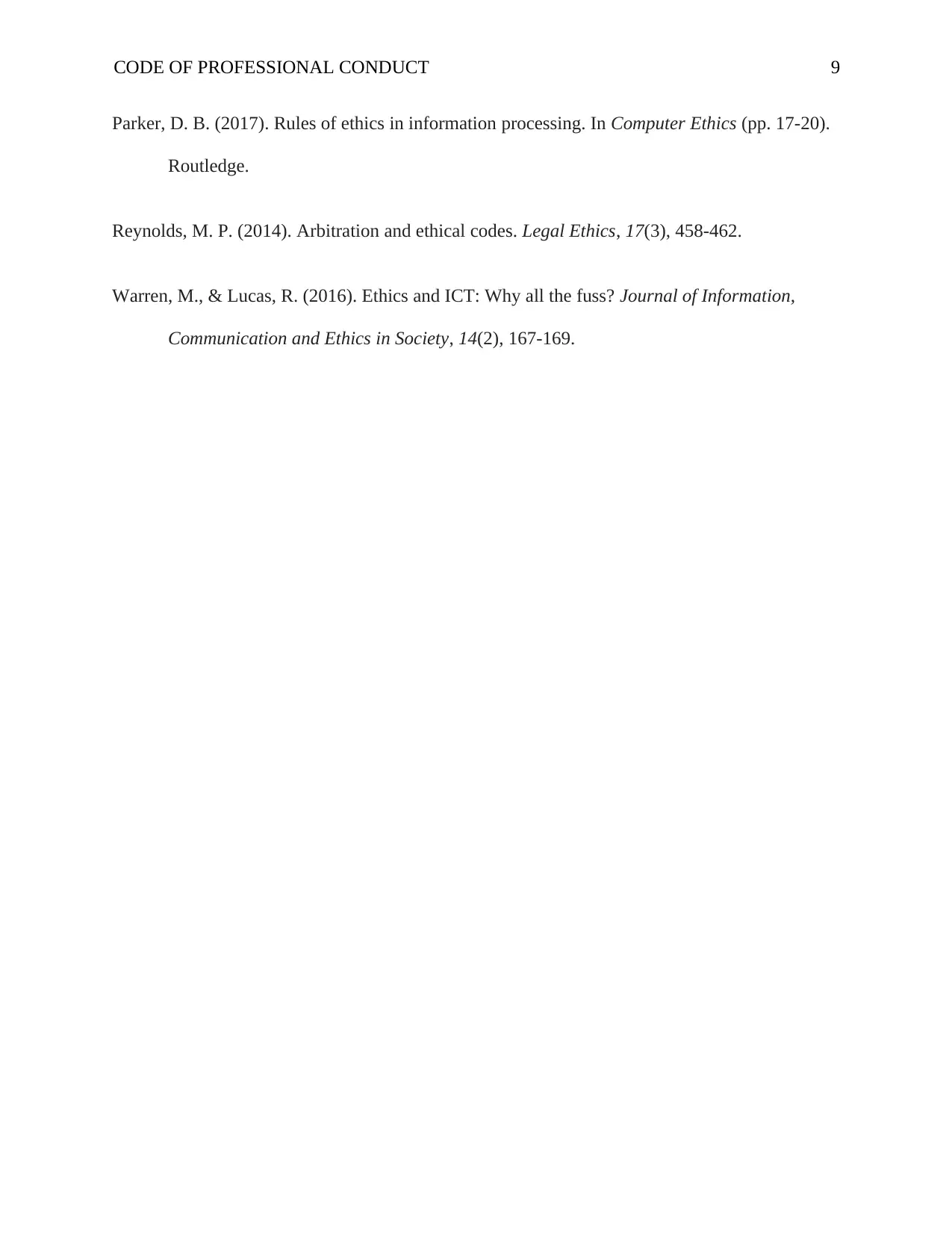
CODE OF PROFESSIONAL CONDUCT 9
Parker, D. B. (2017). Rules of ethics in information processing. In Computer Ethics (pp. 17-20).
Routledge.
Reynolds, M. P. (2014). Arbitration and ethical codes. Legal Ethics, 17(3), 458-462.
Warren, M., & Lucas, R. (2016). Ethics and ICT: Why all the fuss? Journal of Information,
Communication and Ethics in Society, 14(2), 167-169.
Parker, D. B. (2017). Rules of ethics in information processing. In Computer Ethics (pp. 17-20).
Routledge.
Reynolds, M. P. (2014). Arbitration and ethical codes. Legal Ethics, 17(3), 458-462.
Warren, M., & Lucas, R. (2016). Ethics and ICT: Why all the fuss? Journal of Information,
Communication and Ethics in Society, 14(2), 167-169.
⊘ This is a preview!⊘
Do you want full access?
Subscribe today to unlock all pages.

Trusted by 1+ million students worldwide
1 out of 9
Related Documents
Your All-in-One AI-Powered Toolkit for Academic Success.
+13062052269
info@desklib.com
Available 24*7 on WhatsApp / Email
![[object Object]](/_next/static/media/star-bottom.7253800d.svg)
Unlock your academic potential
Copyright © 2020–2025 A2Z Services. All Rights Reserved. Developed and managed by ZUCOL.



